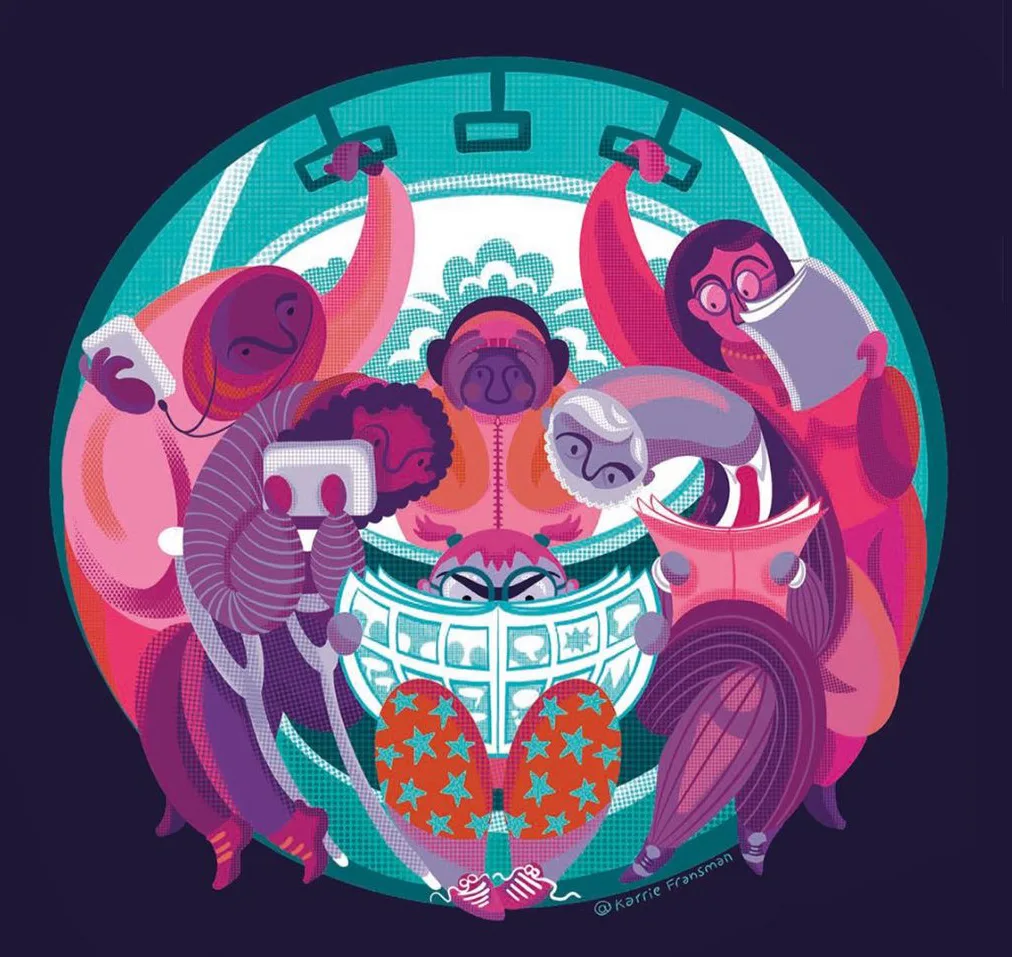Reading Crisis? Well, not among comic readers
By Hannah Berry and Karrie Fransman of The Comics Cultural Impact Collective with an introduction by Debbie Hicks MBE, The Reading Agency

In our recent thought piece, How the Reading Landscape is changing, we argued the need to redefine what we mean by reading and to recognise the value of different access points for those that may not see themselves as readers in the traditional sense. It is important to remember that reading is rich and varied, encompassing the printed word, audio, digital and visual comic content; all highly creative formats for sharing story and narrative and none superior to the other.
Comic books and graphic novels have always been a gateway to reading, particularly for young readers drawn in by the immediacy of visual storytelling. Their increasing popularity is part of a changing landscape in which people’s engagement with narrative and story is shifting, shaped by time pressures and the influence of visual, digital and audio media. For the first time ever, research shows that audio content is now more popular than print for young people aged 8-18, especially boys1.
In our own work, delivering programmes like the Summer Reading Challenge and our Reading Well health programme, we’ve seen firsthand that audiobooks have surged in popularity, playing a significant role in the broader redefinition of reading. During last year’s Summer Reading Challenge, for example, over 800,000 children’s eBooks and audiobooks were borrowed from libraries, demonstrating the appetite for alternative formats. Once a niche market, we can see that they are now a mainstream format embraced by readers of all ages.
In all our book list curation, we work hard to ensure that alongside audio, there is also graphic or comic content to ensure accessibility but also to respond to reader choice and preference. Some examples include Matthew Johnstone’s Living with a Black Dog from our Reading Well for mental health list, Frankie’s World by Aoife Dooley on our Reading Well for teens list and Tony Husband’s Take Care, Son: The Story of My Dad and his Dementia from Reading Well for dementia.
Graphic content, like audio, is essential to a rich and inclusive reading ecosystem. Comics create and connect readers and provide real enjoyment for all ages. Their increasing popularity is helping to shape the future of reading. Over to Hannah Berry and Karrie Fransman of The Comics Cultural Impact Collective to tell us more…
The crisis of reading enjoyment has been widely reported, and is a terrible indictment of young people’s relationship with what is perhaps the best source of inspiration, education, empathy, entertainment and connection.
The National Literacy Trust conducted research into 64,066 young people’s reading habits and reported the lowest level of reading enjoyment since records began in 2005. It’s a desperate state of affairs. However, there is a glimmer of hope which can be found in the crisis’ full title (apparently dropped for the sake of expediency): The Crisis of Reading Enjoyment Among People Who Don’t Read Comics.
Because, as it turns out, the National Literacy Trust’s research also found that nearly twice as many young people who read comics enjoyed reading compared to those who didn’t read comics in their free time (58.6% vs 33.1%)2: this crisis is, apparently, confined to those who don’t read comics.
It is of course vital that we fund libraries and support schools and start building a better relationship with reading from a young age, but perhaps we could also – as The Reading Agency’s Debbie Hicks MBE recently suggested – start thinking differently about how young people and indeed adults are ‘reading’.
We are comics creators and co-founders of The Comics Cultural Impact Collective (CCIC), and saying “well, actually” to those who are suspicious of comics is our reason to get up in the morning. ‘Comics’, defined as ‘sequential art’ by Will Eisner, is a medium which incorporates all genres- from cooking to history, from biographies to sci-fi. The term ‘comics’ encompasses graphic novels, comic strips, manga and digital comics, and they are for every readership from children to adults.
CCIC formed in May 2023 with the aim of raising awareness of the social, educational, psychological and economical value of comics in the UK by gathering together all the compelling research that gives us insight into the reach and power of comics. For example, 40.3% of children read comics. The National Literacy Trust’s research also found that:
- Children and young people who read comics were more engaged with reading, regardless of their age
- More of those who read comics rated themselves as ‘very good’ or ‘good’ readers compared with those who didn’t read comics (86.0% vs 76.3%)
- More of those who read comics told us that they read something daily in their free time compared with their peers who did not read comics (35.7% vs. 22.8%)
And the benefit of comics extends to adults too. 31% of adults read or have read comics, with The Reading Agency’s The State of the Nation’s Adult Reading (2024)3 showing that 27% read graphic novels, comics or comic books once a month or more. These adults are more likely to…
- Be regular readers (55% vs 50% UK average)
- Like talking to people about books and reading (62% vs 41% UK average)
- Say that reading is an important part of their life (73%, rising to 83% of daily graphic novel or comics readers vs 60% UK average)
- Have read together with a member of their family when they were a child (64% vs 58% UK average)
- Say there are lots of things they want to read (72% vs 59% UK average)
- Say reading makes them feel better (71% vs 61% UK average)
- Say they want to read more books featuring characters with experiences similar to their own (59% vs 35% UK average)
The numbers don’t lie: comics are bastions of reading enjoyment. So why is there such a hesitancy around them? Well, it seems they may have been a victim of their own success.
In the early-to-mid 20th century, children’s comics were phenomenally popular, so much so that they became synonymous with being juvenile, fun and disposable. While comics can portray incredible depth and subtlety, their easy accessibility (visual literacy is innate from a very young age) inadvertently meant they were dismissed as facile. Unlike in France, Belgium and Japan, where everyone reads comics (or bandes dessinées or manga), comics in the UK has been slow to recover from these misconceptions.
The hierarchy of word over image persists to this day, but if you move further back in history there is a less clear divide between the two, with Hieroglyphics and Chinese scripts defying these distinctions. And, not that it’s a competition, but comics predates literature: comics can be traced all the way back to prehistoric cave paintings in Lascaux.
History shows us that visual storytelling has existed since humans put pen to paper, stylus to wax tablet, or sticks to sand, and today we are returning to this artform with young people growing up in a much more visually literate world. They are regularly navigating text and images online and are consuming stories through devices, games and screens. Comics have the ability to cross mediums, working as well in print as online. The future of storytelling online will be visual.
But crucially, the reasons people are hesitant to include comics as literature are the very reasons they should be embraced. Firstly, their accessibility: bringing reading to a wider readership. Research suggest that comics audiences are more diverse than those of more traditional artforms, encouraging higher relative rates of participation by minoritised ethnicities and people who identify as neurodivergent. Secondly, they are enjoyable to read. Denying reading pleasure to those who are actively seeking it is like dashing an eclair from the hands of a starving man.
It is time to embrace comics as part of literature to improve literacy, visual literacy and enjoyment of reading amongst children and adults. If you are interested in our work – or in search of documentation to “well, actually” any naysayers – you can find out more about (and perhaps join?) our mission at thecomicsculturalimpactcollective.org
